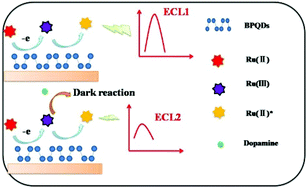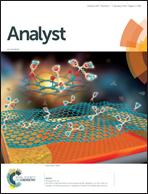Electrogenerated chemiluminescence of Ru(bpy)32+ at a black phosphorus quantum dot modified electrode and its sensing application†
Abstract
Black phosphorus quantum dots (BPQDs) with an average size of 8.2 nm were synthesized through a liquid exfoliation method. The surface morphology and the thickness of the BPQDs were identified by high-resolution transmission microscopy (HRTEM), atomic force microscopy (AFM), and Raman spectroscopy. The electrogenerated chemiluminescence (ECL) behavior of Ru(bpy)32+ was investigated at a BPQD modified glassy carbon electrode under neutral conditions. A strong anodic ECL signal was obtained at the modified electrode in the absence of a coreactant, which is nearly three orders of magnitude larger than that at the bare electrode. Electrochemical results revealed that the oxidation process of Ru(bpy)32+ can be significantly catalyzed by BPQDs, suggesting that BPQDs can act as the coreactant of Ru(bpy)32+ to generate strong light emission. Dopamine could react with the oxidation product of Ru(bpy)32+ and exhibited an apparent inhibiting effect on ECL emission. As a result, it can be sensitively detected in the range of 0.1 nM to 50 nM with a detection limit of 0.022 nM. The present work revealed that BPQDs are a potential ECL platform, and which are promising in the fabrication of a novel ECL biosensor.



 Please wait while we load your content...
Please wait while we load your content...